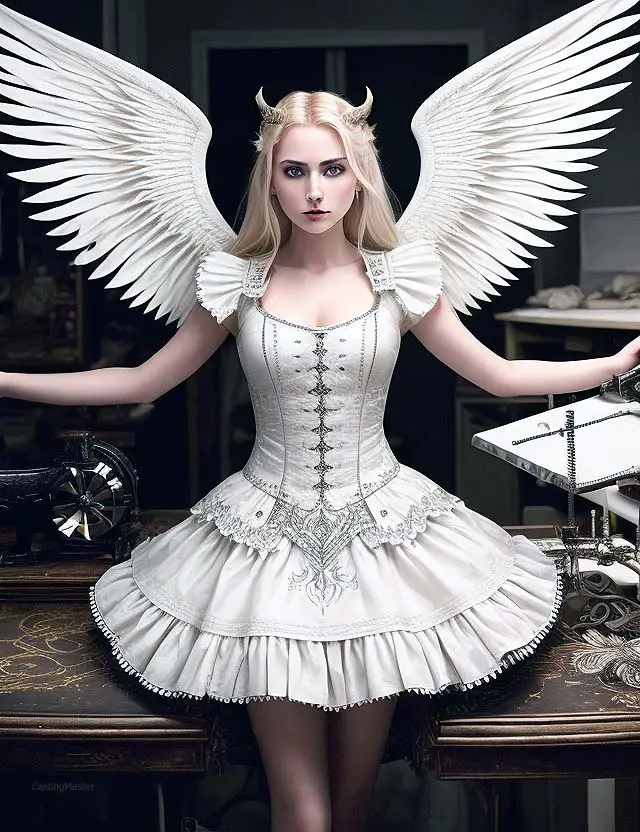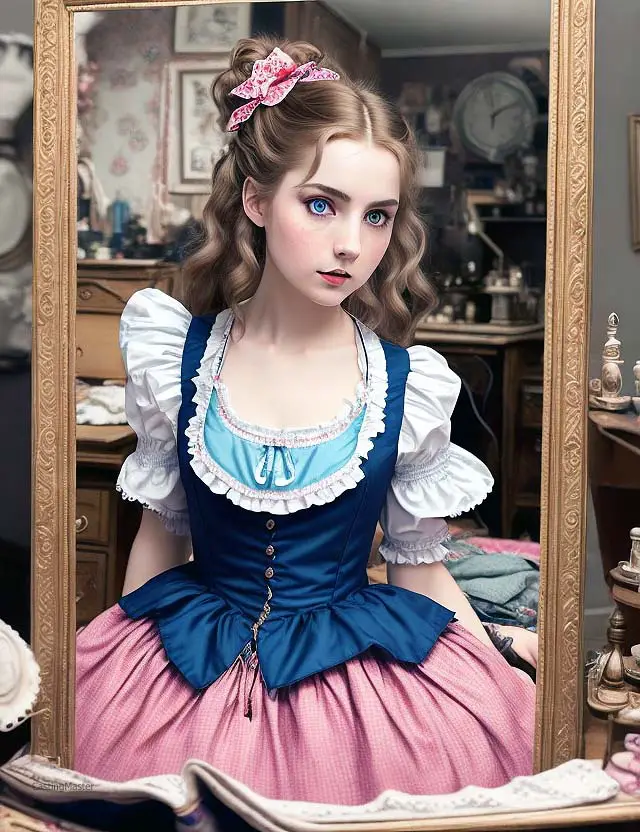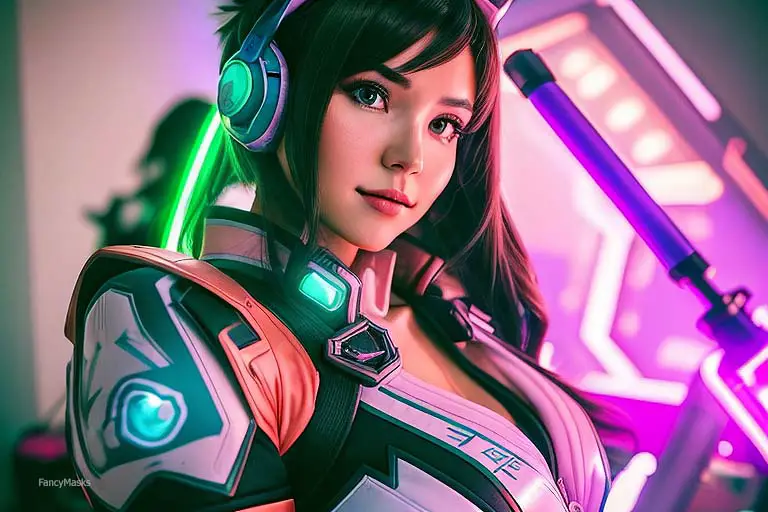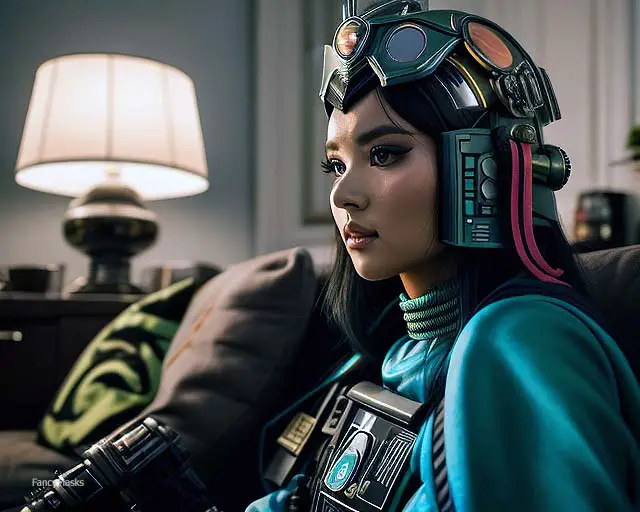When it comes to cosplay, there are few articles of clothing that can rival the corset in terms of versatility and authenticity. From steampunk to Victorian-era characters, corsets have been a staple of cosplay for years, and with good reason. But where did this iconic garment come from?
Let’s dive into the history of cosplay corsets. The origins of the corset can be traced back centuries to Europe, where it was worn as an undergarment by women to shape and support their bodies.
Over time, the design evolved, becoming a fashion statement worn by women of all classes and social standing. In fact, during the Victorian era, the corset was so ubiquitous that it was considered a necessary part of a woman’s wardrobe. In this post, you’ll learn how to creaet an authentic looking cosplay corset.

Fast forward to modern times, and the corset has taken on new life as a defining element in many cosplay costumes. From medieval princesses to superheroes, cosplayers have used this age-old garment to create stunningly authentic looks.
But why is the corset so important for cosplay? For starters, it provides an opportunity for character detail customization; you can add Lace and Trims that reflect your character’s personality or style.
Additionally, because they are often DIY projects – there are many excellent Cosplay Costume Making guides available online – making your own corset allows you complete control over its design and construction. Whether you choose historical Corset Designs or more modern adaptations that fit your costume theme better like superhero or anime-inspired designs – there is no denying that creating your own authentic-looking cosplay corset can be incredibly rewarding.
There are a variety of options depending on your budget. There are modest entry level corsets which will cost under $30 to professional or custom made pieces which can cost several hundred dollars. Regardless of how much you have the spend, there will be options for you to be able to add a corset to your cosplay.
The Critical Role of Authentic Cosplay Corsets
Authentic cosplay corsets play a crucial role in bringing characters to life. They are not only an essential part of many costumes, but they also shape the way the wearer carries themselves.
Corsets have been worn for centuries, and they have come to symbolize both power and vulnerability. When you put on an authentic cosplay corset, you feel like you can take on any character’s persona.
Cosplay is all about creating a character from scratch, and that includes their clothing. For many characters, the corset is the foundation of their attire.
Creating an authentic cosplay corset means taking into account not just the look of a character’s outfit but also how it fits and feels on your own body. The right corset can help you achieve a particular silhouette or posture that enhances your overall cosplay look.

Authenticity is key when it comes to creating a cosplay costume, and this applies to corsets as well. Historical corset designs are often used as references when creating cosplay costumes because they have stood the test of time and can provide valuable insights into construction techniques.
Knowing how to create an authentic-looking corset will give your cosplay costume credibility and make it stand out from others at conventions or events. Creating an authentic cosplay corset is not just about appearance; it’s about embodying the character you’re portraying fully.
A well-made corset will not only enhance your costume but also give you confidence in your portrayal of the character. Consider using historical designs as references for constructing your own cosplays, choose appropriate fabrics for comfortability during long hours wearing it or storing them properly after use by following some simple Costume Storage Tips so that your hard work doesn’t go wasted over time!
Decoding Corset Patterns for Cosplay
When it comes to creating an authentic cosplay corset, choosing the right pattern is essential. There are many patterns available online, and they can range from beginner-friendly to expert-level. When choosing a pattern, consider your skill level, time constraints, and the specific character you are cosplaying.
If possible, try to find historical corset designs that match the era of your character. Once you have selected a pattern, take time to study it thoroughly before beginning your project.
Many patterns come with detailed instructions that can be overwhelming at first glance. Don’t be afraid to reach out to online DIY cosplay guides or forums for help if you get stuck.
To customize your corset to match your character’s unique details, look for areas in the pattern where you can add lace and trims. Adding these details will make your corset stand out and give it an added touch of authenticity.
When selecting fabrics for your cosplay corset project, keep in mind the level of support required for a well-constructed corset. Choose sturdy fabrics such as twill or coutil for the main body of the corset and lightweight fabrics like satin or chiffon for lining.
Overall, understanding corset patterns is a crucial step in creating an authentic cosplay costume piece. By taking the time to research historical designs, studying patterns carefully before starting them,and customizing them with lace and trims , you are well on your way to creating a stunning cosplay outfit.
Choosing the Right Fabric for Your Cosplay Corset
Fabric choice can make or break your costume. The fabric not only needs to look authentic but also needs to hold up during long hours of wear.
When choosing a fabric for your cosplay corset, consider the durability, flexibility, and authenticity needed for your character. Some popular fabric choices for cosplay corsets include brocade, satin, and cotton twill.
Brocade is a luxurious and durable option that works well for historical corset designs. Satin has a shiny finish that looks great on stage and under lights but can be more delicate than other fabrics.
Cotton twill is a sturdy and budget-friendly option that works well with nearly any character. When considering fabric color and pattern, take into account the look you want to achieve as well as any specific details or colors from your character’s design.
For example, if you’re making a Wonder Woman costume, you may want to choose red satin with gold trims to match her signature outfit. Don’t forget about texture when choosing fabrics!
Adding textures like lace or trims can add dimension and detail to your cosplay corset. Additionally, consider adding a modesty panel in your corset design using matching or complementary fabric.
.
How to Measure for a Perfect Cosplay Corset Fit
When it comes to creating an authentic cosplay corset, the fit is everything. A well-fitting corset will not only look better, but it will be more comfortable to wear for extended periods of time. Here are some tips on how to measure for a perfect cosplay corset fit.
It’s important to note that you should measure yourself in your undergarments, or whatever garments you plan on wearing under your corset. This will ensure the most accurate measurements possible.
Use a soft measuring tape and make sure it’s snug but not too tight against your skin. Start by measuring around your natural waistline, which is typically the smallest part of your waist.
Take note of this measurement. Next, measure around the fullest part of your bust.
Make sure the tape is straight across your back and not drooping down in any way. Again, take note of this measurement.
For the hips measurement, stand with your feet together and measure around the fullest part of your hips and buttocks. Make sure again that the tape is straight across and not drooping down.
Now that you have these three measurements, you can use a corset pattern or create custom measurements based on historical corset designs to construct a perfectly fitting cosplay corset. Remember that different fabrics may stretch differently and affect how tightly the finished corset fits on you so make sure choose wisely from available cosplay fabrics based on its properties like elasticity etc.
Take time in marking grommet placements for Busk Closure Creation along with character detail customization using Lace and Trims create an amazing visual impact if used creatively while setting up Boning Techniques can enhance comfort while giving much-needed support. Don’t forget about adding a Modesty Panel in Corsets if necessary – especially if you’re portraying certain characters or attending family-friendly events!
The Art of Constructing Your Cosplay Corset
Now that you have your patterns and fabric all set up, it’s time to start constructing your cosplay corset. The process of putting together a corset can be a bit intimidating, but don’t worry, with some patience and determination, you’ll have an authentic-looking piece in no time.
Make sure you have all the necessary materials. This includes your chosen fabric, any boning or grommets needed for structure and closure, as well as lace and trims for decoration.
Be sure to read through any instructions provided with your pattern or DIY cosplay guide carefully before getting started. When cutting out your pattern pieces from the fabric, take care to cut precisely along the lines to ensure proper fit during assembly.
Always leave a bit of extra fabric at the edges for seam allowances. It’s also a good idea to label each piece as you cut them out to avoid confusion later on.
When sewing the pieces together, use costume finishing techniques such as French seams or flat felled seams to prevent fraying and ensure durability. Once all pieces are sewn together, it’s time for boning installation using historical corset designs techniques like spiral steel boning or cable ties.
For busk closure creation and grommet installation it is important be precise in marking where they will go so that closures are secure when in use. Don’t forget about adding a modesty panel in corsets if desired for added comfort and character detail customization.
After finishing touches like lace and trim application is done clean up any excess threads or fabrics then store your costume properly until ready to wear by utilizing costume storage tips such as folding properly or hanging on padded hangers. With these tips in mind, constructing an authentic cosplay corset can be a fun challenge that adds depth to any character costume design!
How to Install Boning and Grommets in Your Corset
Once you have your corset pattern cut out, it’s time to start adding the boning. Most corsets will require at least one type of boning to give it structure and support. You can use either steel or plastic boning, depending on the look and feel you want for your cosplay corset.
Steel boning is sturdier and more authentic, while plastic is easier to work with and less expensive. When inserting the boning into your corset, be sure to use a bone casing that is wide enough to fit the size of your chosen boning.
You can create these casings by using bias tape or ribbon that matches your fabric color and sewing it onto both sides of each seam allowance. Once you have inserted all of the bones into their respective casings, you can close up any remaining seams on your corset.
Next up is grommet installation for lacing up your cosplay corset. Grommets are eyelets that are placed along each side of the back opening through which laces will be threaded to adjust the tightness of the corset.
You’ll need a grommet tool kit in order to install these pieces properly. To install grommets in your cosplay corset, first punch a small hole through both layers of fabric where each grommet will be placed using your grommet tool kit puncher tool (usually comes with kit).
Then insert one half of each grommet on top side and crimp other half with pliers applying pressure until two halves join together creating secure hole for lace threading . It’s important not to rush this step as unevenly spaced or crookedly installed grommets could ruin all previous hard work done creating beautiful cosplay costume piece!
Creating a Busk Closure for Your Cosplay Corset
When you’re creating a cosplay corset, you want it to look as authentic as possible. One of the most important elements of any corset is the busk closure. A busk is a pair of metal fasteners that run down the front of a corset, allowing for easy on-and-off access and adjustable sizing.
Creating your own busk closure for your cosplay corset will take some time and effort, but it will add an extra layer of authenticity to your costume. First off, you’ll need to gather the necessary materials.
You’ll need a pair of busk closures, which can be purchased online or at specialty sewing stores. You’ll also need some fabric for the front panels of your corset that will hold the busks in place.
Make sure to choose a sturdy fabric like coutil or canvas that can handle the weight and tension of your corset. Once you’ve got your materials together, it’s time to get started on creating your busk closure.
Lay out one panel of your corset fabric flat on a work surface and position one half of the busk closure in place over top. Using a fabric marker or chalk, trace around the edges of the busk so you know where to sew it in place later on.
Repeat this process with the other half of the busk placement on the opposite panel. Next, use a strong needle and thread to hand-sew each half of the busk into place along its traced edges.
It’s important to make sure each half is sewn securely but not too tightly so that they can still open and close easily when worn. With both halves sewn in place, test out how well they fit together by closing them up and making any necessary adjustments before moving onto other steps like adding additional boning or installing grommets for lacing up.
Creating an authentic-looking cosplay corset takes time and patience but creating your own custom busk closure is one great way to add that extra level of detail and quality to your cosplay costume. Whether you’re a seasoned cosplayer or just starting out, taking the time to customize and perfect every part of your costume will pay off in the end with a truly impressive finished product that will stand out at any event.
The Importance of a Modesty Panel in Your Corset
One important aspect of creating a cosplay corset is to ensure that it meets the standards of authenticity. One way to achieve this is by incorporating a modesty panel in your corset. The modesty panel is a piece of fabric that covers the back lacing area of your corset.
This not only adds an extra layer of support but also prevents any skin from showing through the lacing, which can ruin the overall look and feel of your cosplay costume. When it comes to adding a modesty panel to your cosplay corset, there are several things you need to consider.
You must select the right fabric that matches your chosen cosplay character’s costume. You can use anything from lace material or cotton blend fabric to silk or satin for this purpose.
Additionally, you’ll want to make sure that the color and pattern match perfectly with the rest of your costume. Another thing you need to consider when creating a modesty panel is its size and shape.
This will depend on both the size and shape of your corset as well as how much coverage you want in the back lacing area. Be sure to take precise measurements before cutting out any fabric pieces for your modesty panel and then sew them onto your corset with great attention to detail so that it does not detract from the overall design.
If you’re looking for ways to take your cosplay costume-making skills up a notch, incorporating a modesty panel in your cosplay corset is one way to do so. With careful selection of fabrics, sizing, and placement on your corset – you’ll be able not only create an authentic look but also add an extra layer of comfort as well as protection against skin showing through gaps in lacing or other design elements – keeping truest details intact with historical designs at heart!
Adding Authentic Details to Your Cosplay Corset
When it comes to adding authentic details to your cosplay corset, there are countless options to choose from. Whether you’re going for a historically accurate design or adding your own personal touch, lace and trims can be the perfect way to elevate your corset.
Adding a delicate lace border along the top or bottom of your corset can give it an elegant and feminine touch, while larger trims such as ribbon or rickrack can create a bolder statement. Take inspiration from historical corset designs and incorporate these elements into your cosplay creation.
Another way to customize your cosplay corset is by incorporating character details into its design. Consider the personality and style of the character you’re portraying, and think about how you can integrate these features into your corset’s design.
For example, if playing a warrior princess with sharp edges in their costumes, try adding metal accents or studs along the boning channels for a fierce look. If portraying a fairy tale princess look for soft fabrics like satin with embroidered flowers on top.
Additionally, pay attention to little details that may enhance not only the look but also the comfort of wearing it throughout an event. A modesty panel in corsets should be considered as it prevents skin irritation over extended use periods by covering gaps at the back of the corset lacing area while also providing additional support to keep everything in place properly.
Don’t forget about functional elements like busk closures- they should complement nicely with other details in terms of material choice and shape needed for comfortability while still looking great! By taking these factors into account when designing and creating your cosplay corset, you’ll end up with an impressive final product that embodies both authenticity and creativity while being comfortable enough for prolonged wear during events.
The Final Touches: Finishing, Cleaning, and Storing Your Corset
Now that you have completed your cosplay corset masterpiece, it’s time to give it the final touches that will take it from good to great.
The finishing touches can make all the difference in the world when it comes to making your corset look authentic. You can add lace and trims that complement your character’s costume with a few tips from DIY cosplay guides.
A touch of lace trim or some decorative stitching can transform an ordinary corset into a work of art. Be creative and think outside the box!
Before you rock your cosplay event, remember to clean your corset properly. If you’ve used expensive or delicate materials, avoid machine washing; instead clean using a damp cloth with mild soap and water or have it dry-cleaned professionally.
When storing the costume, avoid hanging as this can distort the shape of the corset over time. Instead, fold it carefully in acid-free tissue paper or keep it stored flat in a cool dry place where there is no direct sunlight.
If you’re looking for ways to add character detail customization to your cosplay outfit, consider adding some accessories like hats, gloves or jewelry pieces that would accentuate not only your corset but also other parts of the costume. Additionally, if you’ve chosen historical cosplays like Victorian era costumes designs then check out some of these historical resources for boning techniques on how to insert boning into your Cosplay Corsets which will help give it an authentic feel while also offering support for movement while wearing It’s important not to skip any details when creating an authentic-looking cosplay costume!
Conclusion
Creating an authentic cosplay corset requires a lot of time, effort, and attention to detail. From choosing the right fabric to mastering the art of constructing your corset, every step must be executed with precision and care.
But with the right resources and knowledge at your disposal, creating a stunning cosplay corset that accurately replicates historical designs or character details is definitely achievable. One essential aspect that we covered in this article is the importance of accurate measurements when it comes to creating your cosplay corset.
Without precise measurements, your corset may not fit properly or look authentic. We also discussed various boning techniques and grommet installation methods that are crucial for maintaining structure and proper fitting.
In addition to these technical details, we emphasized the necessity of incorporating a modesty panel in your cosplay corset to ensure comfort and prevent any wardrobe malfunctions during conventions or photoshoots. We also touched upon various lace and trim options for customizing your design as well as costume finishing techniques for an overall polished look.
While this guide covers the basics of creating an authentic cosplay corset, there’s always room for customization and personalization based on character details or historical designs. With DIY cosplay guides available online and a plethora of fabrics to choose from, the possibilities are endless.
Crafting your own cosplay costume accessories such as a corset can be both rewarding and challenging but with practice you can master these techniques. With proper storage techniques you will keep them looking like new year after year so they’re ready for future cosplays!




